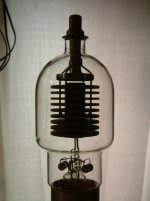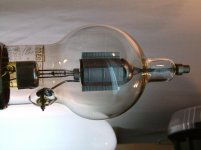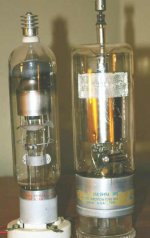I thought it might be fun to try and figure out what some of these old tubes in my stash were, and what they came out of.
The following one I picked up as part of a collection of glass,
which I had grabbed for the round bulbs.
Needless to say, its too big for my tube-tester.
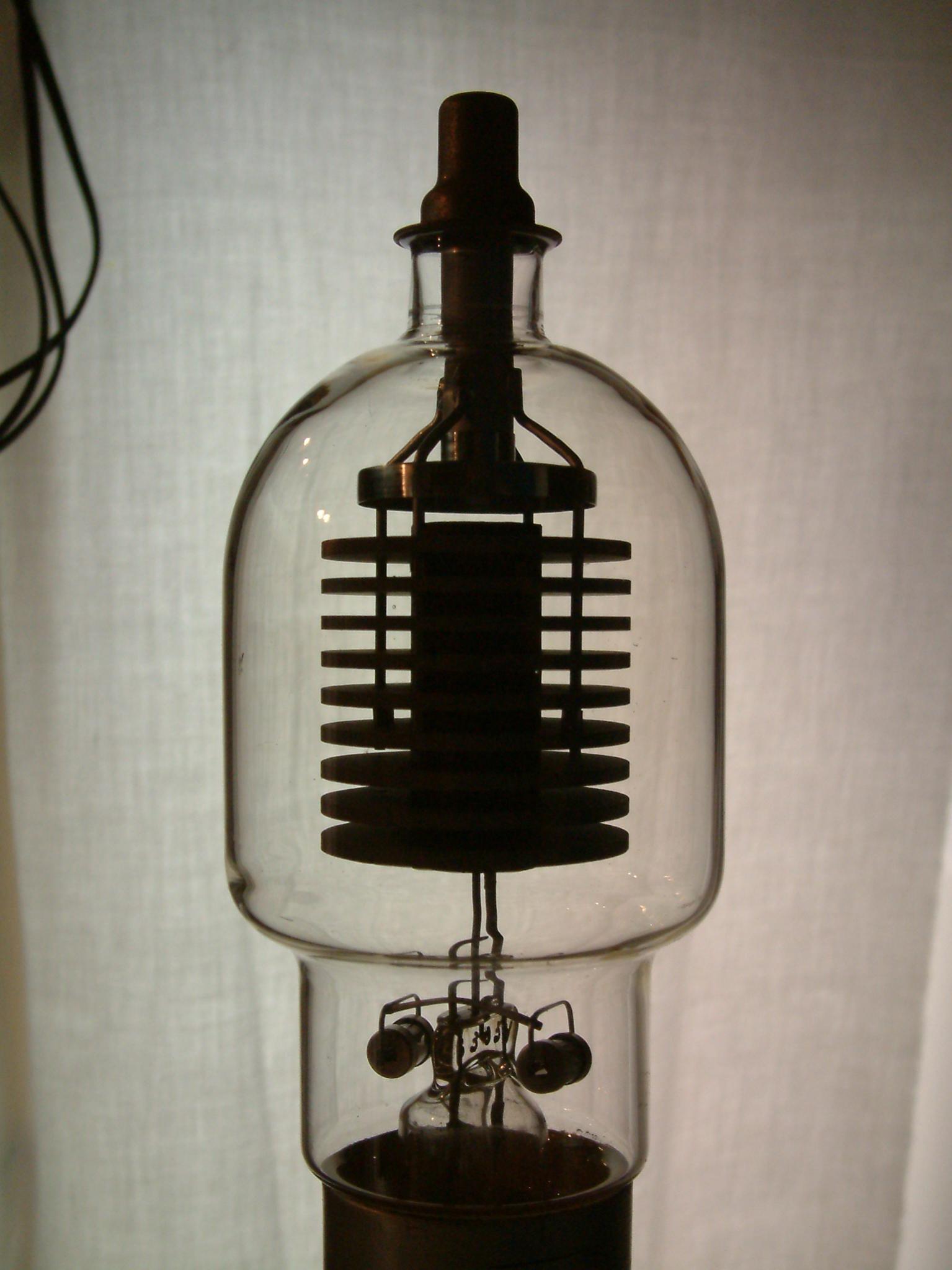
The following one I picked up as part of a collection of glass,
which I had grabbed for the round bulbs.
Needless to say, its too big for my tube-tester.

Attachments
Rectifier.
Nice guess: It probably is.
The the getters (?) on the bottom looke like barbells!
I'm not sure why the anode (?) is formed from 9 disks.
I was recently looking through my stash to see if I had any tubes that used Uranium-glass in any part of their assembly.
I didn't notice any. Also known as 'green-glass',
I think it was used because its heat-expansion was similar to the metal electrodes, and so it would keep the seals tight
under a variety of temperatures.
Here's another (a transmitting tube I think).
I'm guessing these are for serious RF transmitters,
but I have no idea what kind.
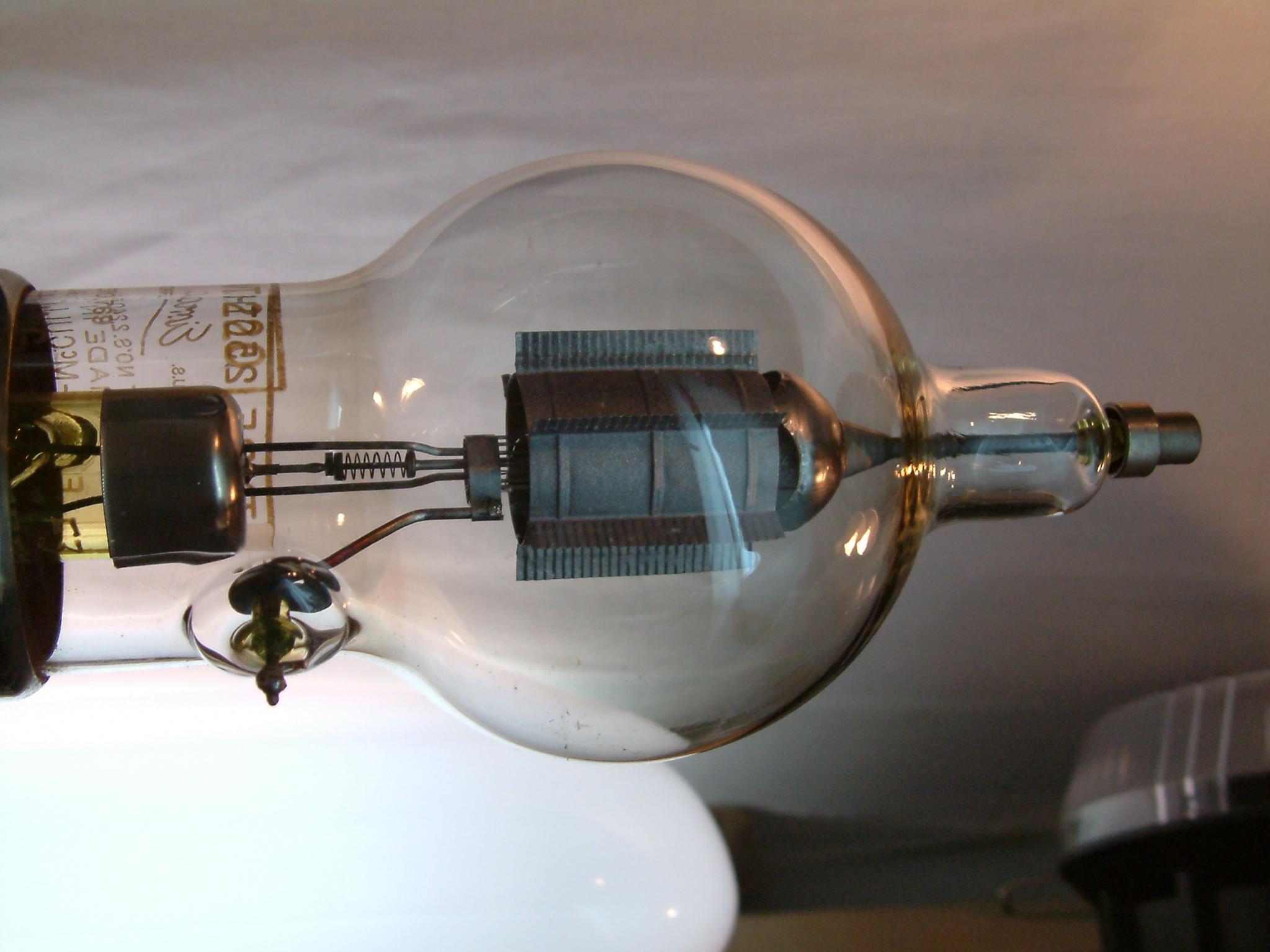
I didn't notice any. Also known as 'green-glass',
I think it was used because its heat-expansion was similar to the metal electrodes, and so it would keep the seals tight
under a variety of temperatures.
Here's another (a transmitting tube I think).
I'm guessing these are for serious RF transmitters,
but I have no idea what kind.

Attachments
Last edited:
The last picture shows the grid connection, revealing it as a triode. The number is visible (backwards) in the previous picture, 250TH, an older Eimac transmitting type.
With plenty of drive, the right transformers, and fingers safely away from the plate cap, it might be the center of a great sounding conversation piece.
With plenty of drive, the right transformers, and fingers safely away from the plate cap, it might be the center of a great sounding conversation piece.
The first tube is a type 6303 aka X-80. It's a high vacuum high voltage rectifier that was made by United Electronics, Newark NJ. You can read about it here. And "riccoryder" is spot on about the second one being an early style Eimac 250TH
I used to buy and sell surplus industrial tubes for gain in years past when they were more plentiful and saleable. In the early sixties Eimac was using a "green glass" at the base of some of their tubes. I don't know if it was urainum (Vaseline) glass or not. But I do know from much experience that the green base tubes had a much greater failure rate from vacuum leakage then other non-green types. So much so that I quit buying them simply based on the color. If that glass was supposed to improve the seal, then it was a failure in my book. They also quit using it some time later.
I used to buy and sell surplus industrial tubes for gain in years past when they were more plentiful and saleable. In the early sixties Eimac was using a "green glass" at the base of some of their tubes. I don't know if it was urainum (Vaseline) glass or not. But I do know from much experience that the green base tubes had a much greater failure rate from vacuum leakage then other non-green types. So much so that I quit buying them simply based on the color. If that glass was supposed to improve the seal, then it was a failure in my book. They also quit using it some time later.
All of the lemon-lime epoxy coated 4-65A's I've ever seen have had loss of vacuum. I assumed that the base coating was a failed workaround for a known defect. I feel sorry for any troops that had to depend on them. Those I tried of the regular flavor all worked. I've seen a few c.r.t.s that had similar treatment. The 15GP22 in the original 1954 RCA CTC-2/CT-100 color television used epoxy on the front seal, apparently causing nearly all to fail.
I don't think there was anything radioactive in the epoxy, but 4-65A's do use a low concentration of thorium in the filaments. Some have the radiation icon on the bottle. I have not seen the original hazard sheets.
I don't think there was anything radioactive in the epoxy, but 4-65A's do use a low concentration of thorium in the filaments. Some have the radiation icon on the bottle. I have not seen the original hazard sheets.
Here's what I found:
The Museum in the University of Electricity and Communication(in Tokyo) owns more than 10,000 vacuum tubes from 1910 to the current age.
I visited here in 2009, and I and the curators found more than 10 vacuum tubes which use uranium glass.
Vacuum tube exhibition room in the Museum
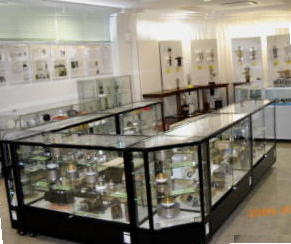
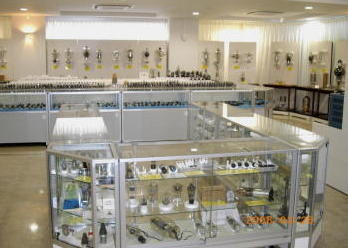
The following are the vacuum tubes using uranium glass.
Upper photo :No.1,to 5,
Lower photo:No.6-7 (No.2) No.8 to11
1.,EIMAC VT-127-A
2,PL PL-185 USN-CBZC-527A (PENTA LABORATORIES)
3,GE GL-4-125A/4D21 (General Electric)
4,EIMAC 4-65A JAN-CIM4-65A
5,EIMAC 100TH JAN-CIM-100TH
-------------------------------------
6,Not uranium glass
7,EIMAC 3-50A4 JAN-35T
8,PHILIPS JAN-CNY-3C24/VT-204
9,PL PL-4-400A JAN-CBCZ-4-100A
10,EIMAC 100th 100th/VT218
11,EIMAC 15E
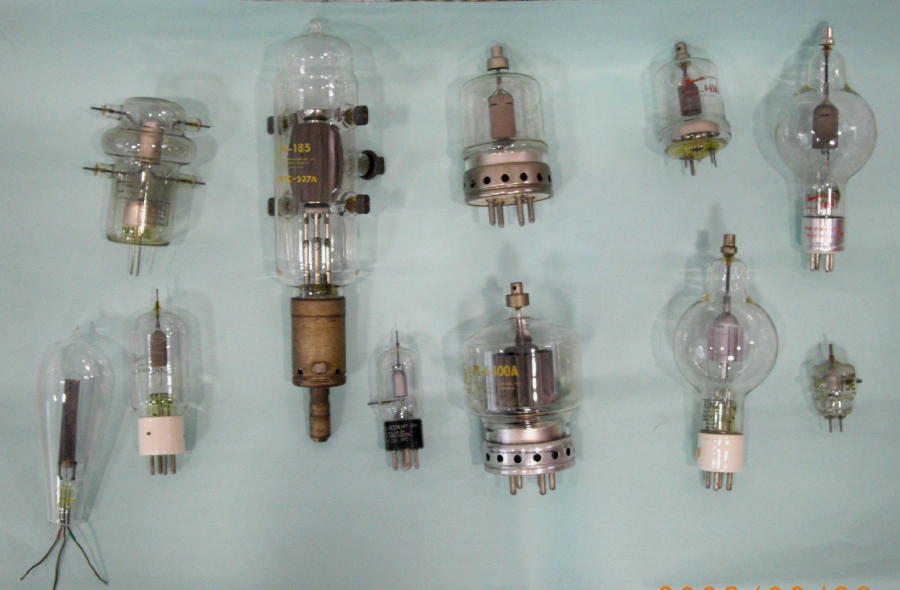 No.4
No.4
,EIMAC 4-65A JAN-CIM4-65A
under UV-light
Top and lower cathode are uranium glass.
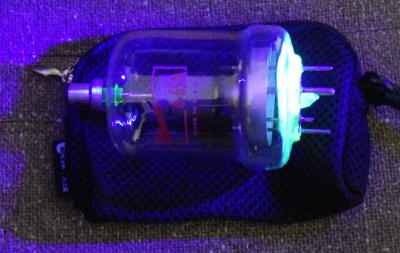 No.5
No.5
EIMAC 100TH JAN-CIM-100TH
under UV-light
Top and lower cathode are uranium glass.
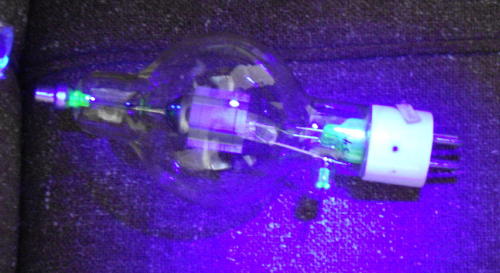
Largest vacuum tube in the Museum.
JAN-CWL-861
(marked as Westinghouse)
natural air-cooling 4-diodes.
made in 1927
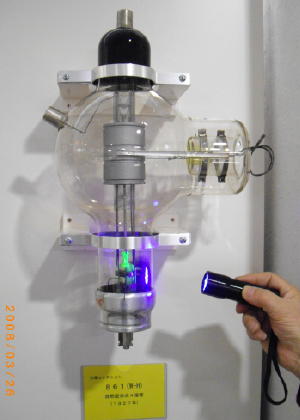 The following 2 tubes are mine.
The following 2 tubes are mine.
Left small one is 3C24, and marked as JAN-3C24/VT-204, Made in USA Phillips.
Right large one (21cm length) is 5C22, and marked as JAN-CADK-5C22/HT-415, made in USA/ Kuthe Laboratories.Top 5cm is uranium glass. This was used as military Radar in the World War II.
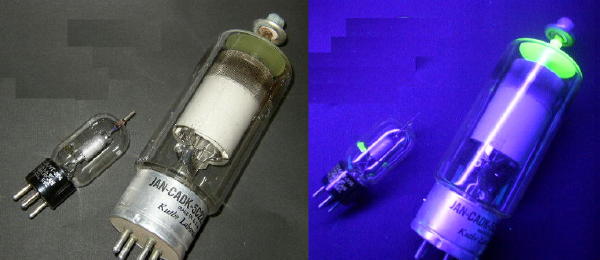
Uranium glass in Vacuum tube
One unique application of Vaseline glass (Uranium glass) is the vacuum tube.
The Museum in the University of Electricity and Communication(in Tokyo) owns more than 10,000 vacuum tubes from 1910 to the current age.
I visited here in 2009, and I and the curators found more than 10 vacuum tubes which use uranium glass.
Vacuum tube exhibition room in the Museum


The following are the vacuum tubes using uranium glass.
Upper photo :No.1,to 5,
Lower photo:No.6-7 (No.2) No.8 to11
1.,EIMAC VT-127-A
2,PL PL-185 USN-CBZC-527A (PENTA LABORATORIES)
3,GE GL-4-125A/4D21 (General Electric)
4,EIMAC 4-65A JAN-CIM4-65A
5,EIMAC 100TH JAN-CIM-100TH
-------------------------------------
6,Not uranium glass
7,EIMAC 3-50A4 JAN-35T
8,PHILIPS JAN-CNY-3C24/VT-204
9,PL PL-4-400A JAN-CBCZ-4-100A
10,EIMAC 100th 100th/VT218
11,EIMAC 15E

,EIMAC 4-65A JAN-CIM4-65A
under UV-light
Top and lower cathode are uranium glass.

EIMAC 100TH JAN-CIM-100TH
under UV-light
Top and lower cathode are uranium glass.

Largest vacuum tube in the Museum.
JAN-CWL-861
(marked as Westinghouse)
natural air-cooling 4-diodes.
made in 1927

Left small one is 3C24, and marked as JAN-3C24/VT-204, Made in USA Phillips.
Right large one (21cm length) is 5C22, and marked as JAN-CADK-5C22/HT-415, made in USA/ Kuthe Laboratories.Top 5cm is uranium glass. This was used as military Radar in the World War II.

After looking at this issue of the radioactive glass components,
I began to be concerned about what I have in my house!
I think these are the largest/oldest tubes I have.
I don't know what either one was for, but from above,
I'd guess that the 5949A was a radar tube(?).
The 5754 I don't know what it is either.
I wish I had a geiger counter.
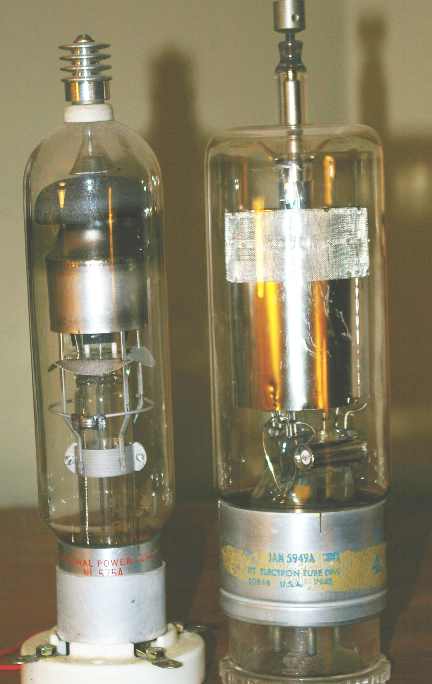
I began to be concerned about what I have in my house!
I think these are the largest/oldest tubes I have.
I don't know what either one was for, but from above,
I'd guess that the 5949A was a radar tube(?).
The 5754 I don't know what it is either.
I wish I had a geiger counter.

Attachments
I recognize the big tube on the right. It is a hydrogen thyratron. They were used to dump the energy in a high voltage capacitor into a magnetron in radar applications. Think 75 KV at 200 Amps. They were also use to initiate the chain reaction in atomic weapons.
Certain hydrogen thyratrons seem to fetch $$$ on Ebay, but they might be used for evil purposes. I sold all of my oddball big military tubes to a tube vendor years ago.
Certain hydrogen thyratrons seem to fetch $$$ on Ebay, but they might be used for evil purposes. I sold all of my oddball big military tubes to a tube vendor years ago.
I recognize the big tube on the right. It is a hydrogen thyratron. They were used to dump the energy in a high voltage capacitor into a magnetron in radar applications. Think 75 KV at 200 Amps. They were also use to initiate the chain reaction in atomic weapons.
Certain hydrogen thyratrons seem to fetch $$$ on Ebay, but they might be used for evil purposes. I sold all of my oddball big military tubes to a tube vendor years ago.
uh oh.
I want my tubes to be used for niceness instead of evil.
On the other hand, how much loot is it worth? I'm also poor.
Perhaps there's a compromise here:
I could sell it to you for half-price!
That would only be half the potential evil, I think.
On the other hand, how much loot is it worth?........Perhaps there's a compromise here: I could sell it to you for half-price!
I have no idea what your particular tube is worth. I searched Ebay for hydrogen thyratron back when I had all that stuff and found some going for $100+ per tube while others went unbid or sold for a few $$.
I got over 100,000 tubes for a few days of manual labor about 7 years ago. I sorted out the stuff that was unusable for audio and sold it off. I was getting between $100 and $250 for a pickup truck full.
I came to realize that I have been paying warehouse rent to keep this stuff for several years and it isn't worth that much. The last lot of tubes from the warehouse goes with me to the Dayton hamfest, and what doesn't sell gets dropped off at a tube vendor on the way home. I plan to be free of rent payments by July.
Itook your hint and checked Ebay.
Something quite similar to my tube is selling for about $50!
I love that line: ("may be missing original packing", ...may be a factory second or defect"...) LOL
That phrase covers one's *** well, selling used item as 'new'...
Gee I had hoped for more than $50 though.
Guess I'm not rich yet.
Something quite similar to my tube is selling for about $50!
A new, unused item with absolutely no signs of wear. The item may be missing the original packaging, or in the original packaging but not sealed. The item may be a factory second or a new, unused item with defects.
I love that line: ("may be missing original packing", ...may be a factory second or defect"...) LOL
That phrase covers one's *** well, selling used item as 'new'...
Gee I had hoped for more than $50 though.
Guess I'm not rich yet.
- Status
- This old topic is closed. If you want to reopen this topic, contact a moderator using the "Report Post" button.
- Home
- Amplifiers
- Tubes / Valves
- What is it? Tube guessology
